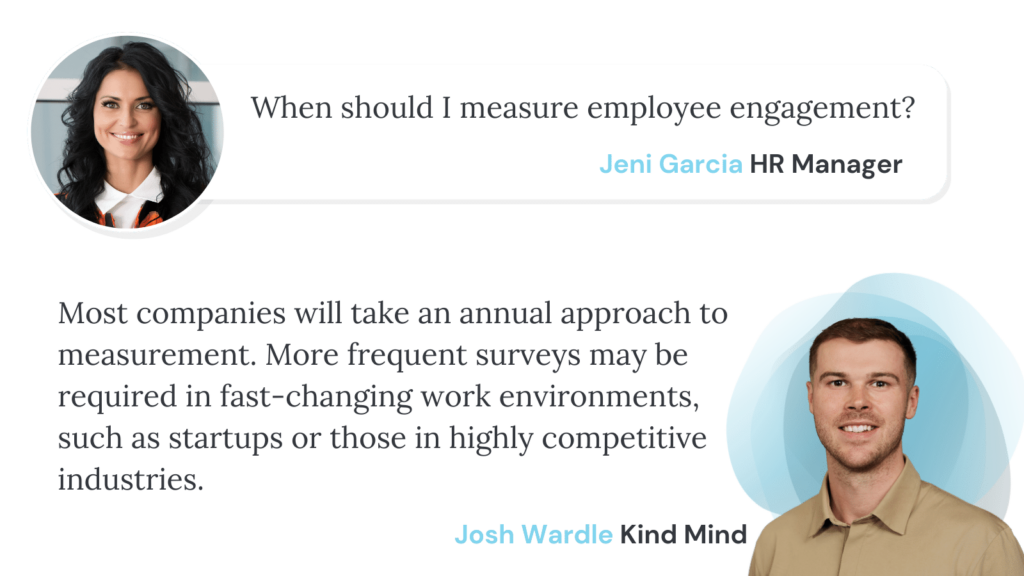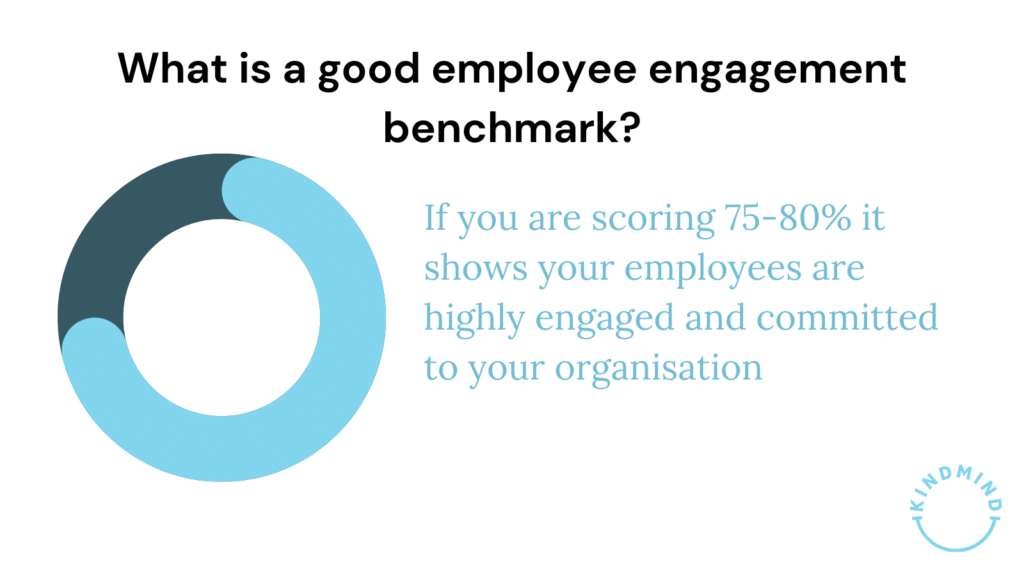You want to know how invested your employees are in your business, but you aren’t sure how to measure that. Well, there is a metric called an employee engagement score that can help. Quantifying it can be pretty complex, so let’s dive into our Kind Mind guide and get you started.
What is an employee engagement score?
Let’s start with employee engagement and ask what employee engagement is.
Employee engagement can quantify an employee’s commitment, enthusiasm, and dedication to their job and organisation. Engaged staff are more invested in their work and are more likely to go above and beyond their job requirements. They feel a sense of pride and ownership in their work and are motivated to contribute to the company’s success.
Engagement is often measured through surveys and feedback mechanisms and is influenced by various factors such as workplace culture, leadership, communication, opportunities for growth, and recognition and rewards.
High levels of employee engagement can lead to improved productivity, job satisfaction, and overall organisational success.
An employee engagement score is a metric that is used to measure the level of engagement and motivation of employees within an organisation. It is typically determined through an annual survey.
Why measure employee engagement at all?
Measuring employee engagement is vital for several reasons:
- To understand employee satisfaction and morale – Employee engagement surveys and feedback mechanisms provide insights into how employees feel about their work, their colleagues, and the organisation as a whole. This information can help employers identify areas of improvement and take action to address issues that may be impacting morale.
- To identify areas for improvement in the employee experience – Measuring employee engagement can help identify improvements to in-house strategies. For example, communication practices, opportunities for growth and development and recognition and rewards programs can all impact employee engagement.
- To increase retention and reduce turnover – Engaged employees are more likely to stay with an organisation, reducing turnover and the associated costs of recruiting and training new employees.
- To improve productivity and performance – Engaged employees are more productive and perform better than disengaged employees. Measuring staff engagement can help organisations identify factors that contribute to engagement and take action to improve productivity and performance.
Let’s consider how often you should measure this in your HR process.

How often should you measure employee engagement?
The frequency of measuring employee engagement depends on your organisation’s size, culture, goals and sometimes lifecycle stage.
Annual surveys provide a comprehensive view of employee engagement trends and allow organisations to track progress over time. However, depending on the speed of change within your organisation or if specific issues arise, more frequent surveys may be required to identify problems and take action more quickly.
Organisations with fast-changing work environments, such as startups or those in highly competitive industries, may need to measure employee engagement more frequently to stay ahead of changes and identify potential risk areas before they become significant issues. For this, they might not rely on a full annual survey format but instead ask for feedback on specific scenarios or programs.
It is also essential to consider the timing of the surveys. For example, conducting surveys during change or organisational restructuring may produce different results than surveys conducted during more stable periods. Then again, surveys were more common during the Pandemic (a very unstable time) as staff switched to remote and hybrid working. This allowed companies to understand how good and bad company culture affected productivity.
How to measure your employee engagement score
Here are some standard methods for measuring employee engagement.
Employee surveys
Conducting surveys is among the most common ways to measure employee engagement. You can use an online survey tool to gather employee feedback on various aspects of their job, such as work environment, leadership, and job satisfaction.
One-on-one interviews
Conducting individual interviews with employees can help you better understand their feelings and attitudes towards their job and the organisation. This can help you identify areas for improvement and develop strategies to boost engagement.
Focus groups
Holding focus group discussions with employees can help you gather qualitative feedback on various aspects of the workplace, such as communication, culture, and management. This can help you identify common themes and issues impacting engagement.
Performance data
Analysing performance data, such as employee turnover rates, absenteeism, and productivity, can also provide insights into employee engagement levels.
Once you have gathered data through one or more of these methods, you can calculate your employee engagement score by analysing the results and comparing them to industry benchmarks or your organisation’s historical data.
The score is usually calculated based on the percentage of employees who report being highly engaged versus those who report being disengaged or neutral. The higher the engagement score, the more likely employees are motivated, productive, and committed to the organisation’s success.
So are there more detailed metrics you can look at for top-level insight?
You can be more detailed in your HR analytics. Rather than looking at a general percentage score for employee engagement, you can break that down and score based on key factors. Let’s take a look at how to do that.
- Determine your key engagement factors – Identify the key factors contributing to employee engagement in your organisation. These include job satisfaction, workplace culture, leadership, and employee development opportunities.
- Design your survey – Create an anonymous survey that asks employees to rate their satisfaction with these factors on a scale, such as a Likert scale. For example, you might ask employees to rate their satisfaction with their job on a scale of 1-5, with 1 being very dissatisfied and 5 being very satisfied.
- Calculate the average scores for individual insights – Once you have collected the survey responses, calculate the average score for each engagement factor by adding the scores and dividing by the number of respondents. For example, if you have 100 employees and 80 respond to the survey, you would add up the scores for each factor and divide by 80.
- You can also use this data to determine your overall engagement score – To calculate the overall engagement score, you can take the average score across all engagement factors or weigh the factors based on their importance to your organisation. For example, if employee development is a critical factor for your organisation, you might weigh that factor more heavily in the overall score.
Remember that the specific formula for calculating an employee engagement score may vary depending on the survey questions, response scales, and weighting used. The important thing is to use a consistent methodology and track changes over time to measure progress in improving employee engagement.
What is a good employee engagement benchmark?
There is no one-size-fits-all benchmark for employee engagement, as it can vary depending on the industry, company size, and other factors. However, there are some general benchmarks that can be used as a starting point. These are:
Overall engagement score
A good overall engagement score is typically in the 75-80% range, meaning that 75-80% of employees are highly engaged and committed to the organisation. Remember your industry variances because higher-pressure environments would have a naturally lower engagement rate.

Employee satisfaction
A good benchmark for employee satisfaction is around 80%, meaning that 80% of employees are satisfied with their job, team, and the organisation as a whole. Most companies measure this on a Likert scale, so translate your findings into percentages so your insight reports read well as a top-level overview.
Employee turnover rate
A good benchmark for employee turnover rate is around 10%, meaning that 10% of employees leave the organisation each year. Again this will vary by industry and the size of your company.
You could alternatively look at employee retention rates – we have a guide for that here.
Absenteeism rate
A good benchmark for absenteeism rate is around 2-3%, meaning that employees are absent from work for 2-3% of their scheduled work days each year. In our guide linked at the beginning of this paragraph, you will find the absenteeism rate also express in days.
Employee productivity and performance
You could also measure employee productivity and performance. Whilst benchmarks are very much based on industry, we have made guides for you to make your calculations.
Employee wellness
“Wellness” can feel like a complex metric to calculate; after all, what is wellness but a mix of factors that contribute to the mental, physical, emotional and social health of your employees? We have created a complete guide for you to help you think more deeply about this complex issue.
Employee advocacy
Benchmarks vary wildly from industry to industry and depend on your specific advocacy programs. A simple Employee Net Promoter Score (eNPS) may help you understand this one better. A good eNPS score is between 10 and 30; above 30 is excellent.
Employee feedback and participation
Finally, you’ll want to measure how engaged your staff are with feedback programs. A reasonable rate of responses is 70-80%.
Remember that these benchmarks are just a starting point and should be used as a reference rather than a strict rule. Setting benchmarks based on your organisation’s unique circumstances and tracking progress over time is essential. By setting realistic benchmarks and monitoring progress regularly, you can identify areas for improvement and take steps to boost employee engagement and drive success.
How to start improving your employee engagement score
Employee engagement is critical for creating a positive and productive work environment. Employee engagement scores measure how connected and committed employees are to their work and organisation.
Here are some steps to start improving your employee engagement score:
- Communicate clearly – Establish clear lines of communication between managers and employees. Communicate company goals, values, and expectations to employees regularly and provide opportunities for employees to share their ideas and feedback openly and without judgement.
- Provide feedback and recognition – Provide employees with regular feedback on their performance and recognise their contributions to the company. This will help employees feel valued and engaged.
- Promote work-life balance – Encourage employees to maintain a healthy work-life balance by providing flexible work arrangements, paid time off, and holistic, science-based wellness programs (like Kind Mind).
- Provide opportunities for growth and development – Offer employees opportunities for professional development, training, and career advancement. This will help employees feel challenged and invested in their work.
- Foster a positive work environment – Create a positive work environment that values diversity, teamwork, and collaboration. Encourage employees to work together and build relationships with their colleagues.
- Improve management practices – Train managers to be influential leaders who inspire and motivate their teams. Ensure that managers are accessible, approachable, and supportive of their employees.
- Conduct employee surveys – Gather feedback on the work environment, management practices, and job satisfaction. Use this feedback to make informed decisions and implement changes to improve staff engagement further.
Remember that improving employee engagement is a continuous process requiring ongoing effort and commitment from staff and management.
Good luck.
Looking for more guides on HR benchmarks? Read our latest articles here.






